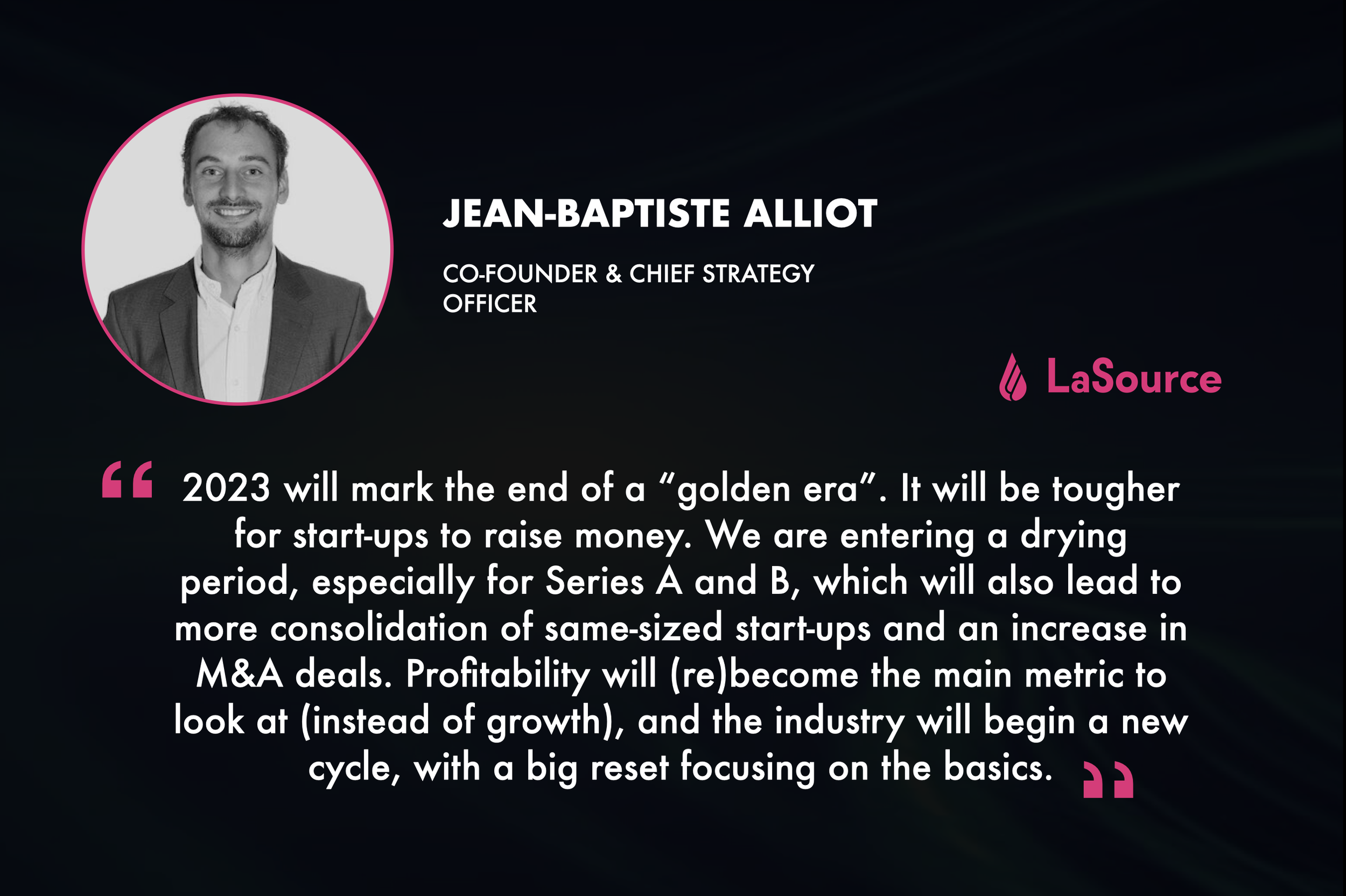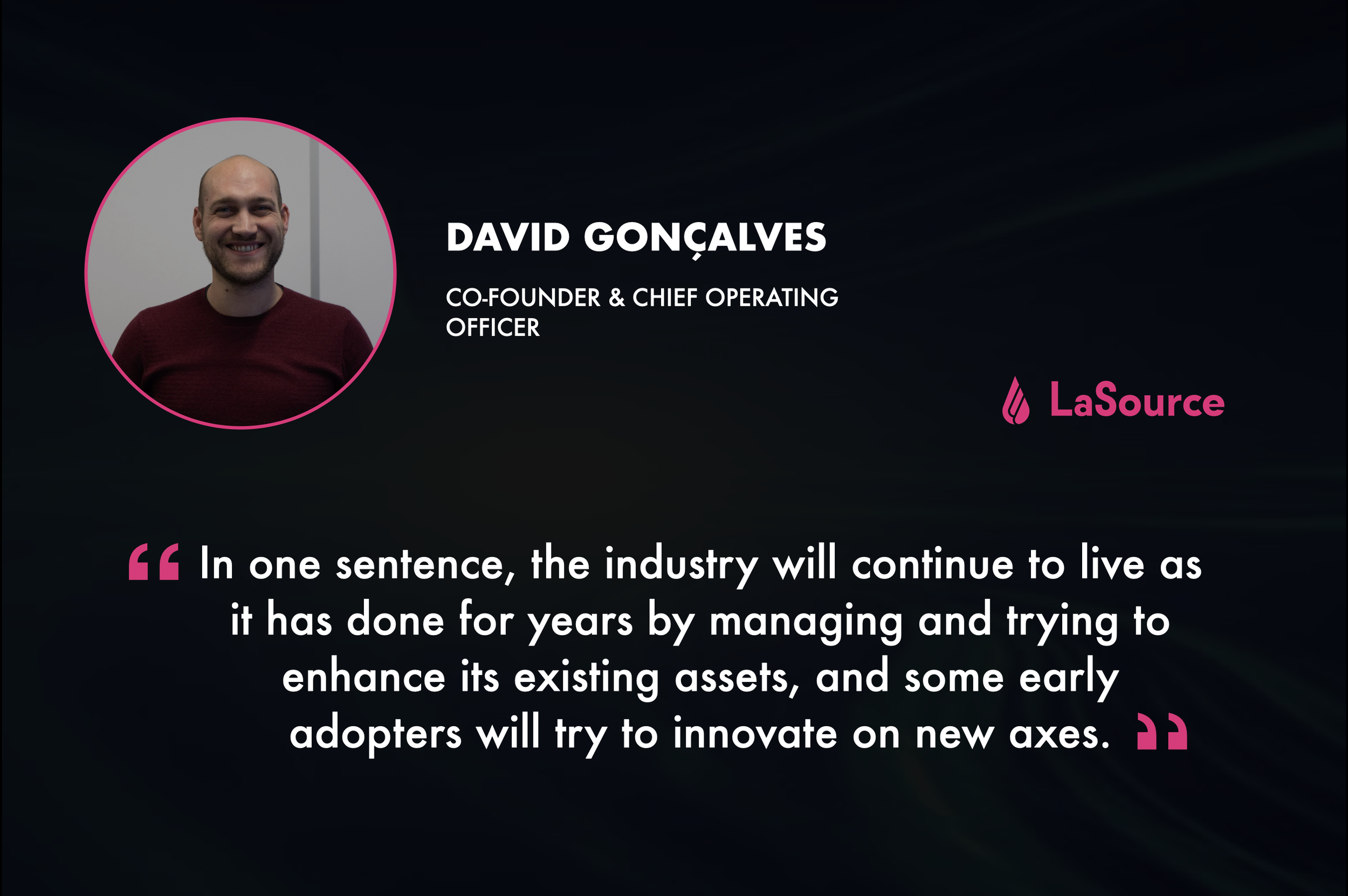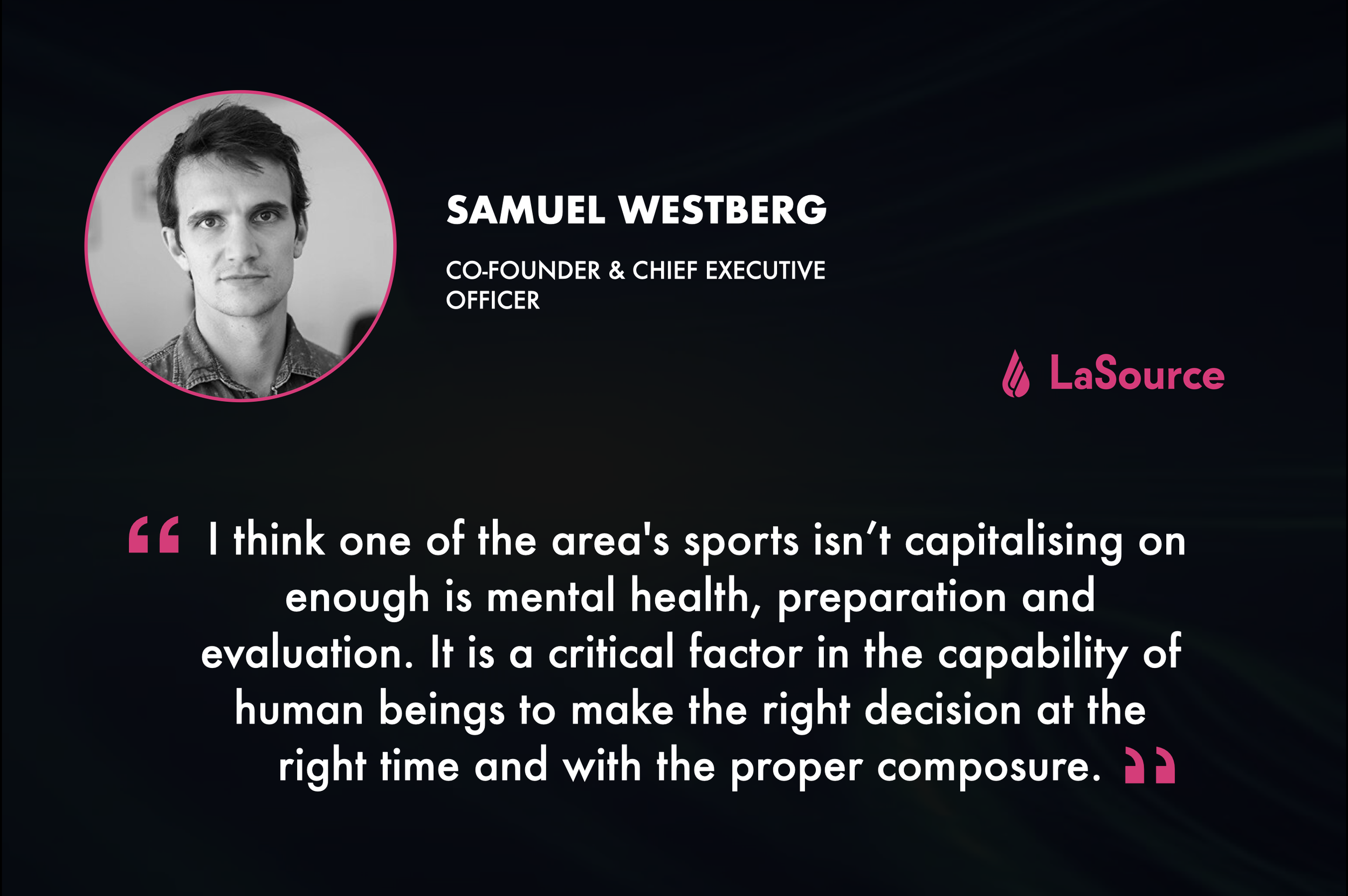What will Sports Tech look like in 2023?
Since 2020, we have been having fun trying to guess what will happen in the sports tech space over the coming year. Unfortunately, our crystal ball is yet to be perfect, and we have had varying degrees of success, but this content piece is also a way to reaffirm our position and belief.
New technologies are essential to sports development and will be the key driver for its upcoming growth in every aspect (amateur, performance, business, etc.). However, it needs the correct understanding, integration process and usage to be truly successful and an enabler.
Thus, beyond the business trends and revolutionary technologies, it is essential to question the capacity of our industry's leading actors to understand, implement and manage them.
What technological developments or trends do you expect to see in the sports tech industry in 2023?
Jean-Baptiste Alliot:
Investment side
The main trend I see for 2023 is the confirmation of what we predicted in Q1/Q2 2022 and started to experience in Q3/Q4 2022: it will be tougher for start-ups to raise money. We are entering a drying period, especially for Series A and B, which will also lead to more consolidation of same-sized start-ups and an increase in M&A deals. Profitability will (re)become the main metric to look at (instead of growth), and the industry will begin a new cycle, with a big reset focusing again on the basics.
2023 will mark the end of a “golden era” which started the last decade and saw many start-ups coming in with new products/services/ideas with the possibility to raise funds quickly and easily. From now on, the level of funding available will be drastically lower, and industry professionals will be tougher on due diligence and savvier about the different technologies available – many emerging products/services/ideas are redundant to existing offerings. What does it mean for start-ups? Even more than before, be well-positioned, understand the market/fit perfectly, and be more than prepared to raise funds in 2023.
Macroeconomic context (explaining the investment side)
This is due to multiple factors from the macroeconomic context: inflation, higher interest rates with a high cost of capital, drop in valuations, record debt, high volatility, market uncertainties with cord-cutting intensifying and churn becoming a real focus in 2022.
The subscription economy is being challenged, and the media landscape will be even more shaken in 2023 than in 2022. Mergers and bundling are happening faster than expected, and it will continue to expand audiences, reduce churn and diminish acquisition costs. 2023 will be the year of mergers and bundling.
What does it mean for start-ups?
Even more than before, be well-positioned, understand the market/fit perfectly, and be more than prepared to raise funds in 2023.
Business side
Just like for Media and Tech, COVID-19 and the lockdowns have proved how the sports industry was and remain unprepared for Next-Generation consumption. Should the pandemic repeat itself today, the sports industry would be in the same situation, but with an ever-worsening economic situation. It has failed to prepare itself for the aftermath, and as I said over and over, the issues the industry face today are the same as before but just greatly accelerated. In leaders' minds, innovation has become a “must” instead of a “nice to have”, but nothing has truly changed in concrete terms.
Thus, 2023 will be the year whereby sports organisations need to address the same issues and accelerate their transformation to meet the needs of their consumers, both on the business and practice side. New competition organisers and formats like PTO, Paddle tennis, Overtime, LIV Golf, etc., will also gain more weight thanks to this situation.
There are two other trends and predictions:
Forget the Millennials and Gen-Z; welcome Generation Alpha.
Big brands will start discussing what to do with that new age group starting at 14 years old next year. This is mainly due to their impact on decision-making in most multi-generation homes for the next decade for TV, audio, social media, gaming, and so sport.
Forget the technology; welcome the usage first.
2023 will be Web 2.1, on the way to Web3. Sports organisations and tech companies at large need to stop focusing on the tech itself, but rather on what it can bring to their fans and consumers. The potential is undeniable, and the technology is here to stay. But the industry needs to look at it backwards to ensure mass adoption. Yet, we can expect significant sports events on Roblox/Fortnite/etc. platforms in 2023 to reach new audiences, increase fan community and figure out what comes next for Web 3.0. On this journey to the creation of the new version of the internet, beyond these platforms’ “escapes”, I believe 2023 will also be marked by the development of Mixed Reality with the arrival of new headsets to mainstream markets.
You must crawl before you walk – For these two trends, sports organisations must remind themselves of the first point and that they need to consolidate their offerings and tech stack first before overthinking ahead.
Last prediction - The athlete era
This one is very personal, and I am not sure why I see it more in 2023 than in any other year. 2023 will be a tipping point in Europe for the consolidation and expansion of the athletes' era.
The US and north-American athletes are way ahead, and we have already seen positive signs of European athletes engaging in the sports tech ecosystem, but 2023 will mark the beginning of a new era whereby players and athletes will have more and more power and willingness to control and stand for their values.
They will be more involved and will have more to say. After the dominance of international and national organisations, we have witnessed over the past 2–3 decades the dominance of clubs within the sports industry.
Now is the time for players to gain even more power and take more control to dominate to their advantage, under their terms and conditions, the rules of the sports industry.
Of course, I have not mentioned AI and its potential, which has become concrete to most professionals in every industry after the explosion of ChatGPT… But I let other ones speak about this!
Samuel Westberg:
I see three trends being important:
AI and ML: I think we will reach a point where AI maturity will automate many of the tasks currently made by humans and help people win a lot of time. The only question is still how fast the cubs will accept this transition.
Fan Engagement: I think that fan engagement will be at the centre of attention for two reasons: we are in a society where everybody gives their opinion and wants their opinion to be heard. It means that organisations need to trigger Calls to Action throughout their platforms to capture and reuse the 1st party data effectively, which is the gold mine for any advertiser.
Internationalization: Finally, without focusing on a particular vertical, I think capitalisation on international communities will be key for the bigger ecosystem players and where most of the growth will come from rather than local/in-venue revenues.
David Gonçalves:
We will arrive at a consolidation of the technological offer in specific sectors of our industry. It is impossible to compare trends in fan engagement, a term that has now become much too generic, sports performance or web3, which remains a cross-industry trend.
On the other hand, we can already observe the difficulty for sports organizations to innovate while keeping a sure consistency in their investments. The logic of asset management has never been as strong as it is now, with private equity investments, and profitability has become key in certain territories after the ultra competition between broadcasters during the three past years.
Ultimately, tomorrow's trends will be linked to the industry's economic structure. Technologies helping to promote TV rights will continue to develop and offer an axis of innovation (content capture, formats, archiving, metadata, and workflows). The same goes for merchandising and ticketing, which remain key sources of revenue.
Here, the tech offer's consolidation is important to benefit the industry from economies of scale. The business model of these suppliers is also significantly correlated to the sales made. It is, therefore, essential to reduce the costs of developing and maintaining platforms as much as possible to remain competitive. If a supplier has a lot of customers, then he can lower his operating costs, and the whole industry will benefit.
This, therefore, responds to the desire of organisations to control their costs and make it possible for the supplier to be profitable. The differentiation will be made for its additional revenue-generating services and TV rights. The simple gimmick continues to grow the industry's leading revenue streams.
Sponsorship will also be challenging with the intense competition due to the economic situation. Sponsorship without consideration (excluding sponsorship linked to a state) tends to disappear.
Therefore, each organisation must know how to qualify its audience, animate it and collect enough first-party data for future contracts. We had the example of the latest deal between Barcelona and Spotify.
Companies will continue to put data ownership at the centre of their strategy for the next few years (moving from data creation to its valuation as an exclusive owner). There will also be two strategies for sports data here, with companies wanting to monetise it or make it open source to increase knowledge around the sport.
The fan data will be linked to the primary sources of income of the organizations I mentioned earlier. The last most crucial asset is on the pitch: the athlete. Many initiatives will continue to emerge to protect and enhance these assets as much as possible. Sports performance tools are democratised in clubs, and the new generation of coaches and staff joining big clubs (like Chelsea) will only confirm this trend.
Finally, risk reduction is one last element in this asset management strategy. The latter mainly involves diversifying current and future sources of income. This is where we will see the most innovation in novelty. However, two strategies will oppose each other: those who anticipate and invest, those who will first be in complete control of their cost, and those who will be the "followers".
In that area, we will still see initiatives around the web3 continue at the following big events, but with a little less "big anything". Organisations will understand that they must already master their web2 strategy.
How will sports organisations and teams adopt and use sports tech in 2023?
Jean-Baptiste Alliot:
There are few chances that sports organisations will become tech-savvy and advanced in innovation maturity. We all know that this market and sports organisations are relatively slow to adapt, and as mentioned in my previous answer, there is still a lot to be done to be fully prepared in the aftermath of Covid-19.
Few organisations, already the most advanced, will continue to lead the way by experimenting and trying new technologies to solve their business needs best and expand their fanbase alongside revenues.
Hope exists because sports organisations' leaders have understood and concretely experienced the need for change and adaptation due to COVID-19. Now it needs to turn into concrete actions, whereby a playbook is required for every organisation to start transforming itself.
I believe we will see more and more sports organisations trying to engage in such a new direction and try to cope with the new demands and needs of fans for their sport.
Samuel Westberg:
I will speak about what I know the most about the European Sports Business instead of sports performance. And it will move slowly - the sports industry is not a fast-moving market, and change takes time, whether because of governance structure or lack of understanding of the need for change at every level.
That being said, with private investments now taking pieces or full ownership of clubs and leagues, I hope to see more adoption of software tools to create value vs staffing up to complete manual tasks as it has mostly been done historically.
David Gonçalves:
Adoption is a challenge for any technology provider. The sports industry has already needed more time than other industries to have a logic of licence payment and regular solution use. It is linked to the economic structure once again.
Since revenues depend on many external factors, organisations prefer to insure with a short-term vision to limit expenses incurred. This trend is still changing thanks to strengthening brand strategies, particularly among clubs (and therefore by the domino effect of the leagues) which stabilises revenues. Manchester United will remain a big brand, even if good results are missing during a few seasons. Adoption is therefore linked to this situation.
The organisations that will adopt technologies well will be those that plan for the long term on a strategy with their partner. This strategy will also be necessary to consider the organisations that set up the right ecosystem to make things work. Yes, more than buying a solution and a licence are required.
It will always be necessary to put the right processes and human resources in place to achieve the success of a project, nonly have understood this. If this work is done well, then the adoption will be excellent.
According to you, which sector within sports tech will see the most significant growth in 2023?
Jean-Baptiste Alliot:
As mentioned before, we have reached the end of a “golden era”, and growth will have another definition and meaning in the months/years to come.
Fan engagement will continue in 2023 to drive most of the investments within sports tech with direct implications on the business and revenue sides of things. However, sustainability and purpose are one of the main challenges and areas for development within the sports industry.
It is not directly aimed at the sports ecosystem, but the climate crisis we are facing, as well as new legislation and the global economic order with the high volatility of energy prices, etc., will drive and enforce the development and adoption of products/services/solutions that contribute to reducing the impact of sports organisations.
Samuel Westberg:
I will bid on something I know less about, but I feel it is undervalued and start seeing traction around. I think one of the area's sports isn’t capitalising on enough is mental health, preparation and evaluation. It is a critical factor in the capability of human beings to make the right decision at the right time and with the proper composure.
We often attach a lot of value to technical skills or speed, for example, when we talk about talent, but one’s mental aptitude to approach events is fundamental and has, I believe, room for improvement.
David Gonçalves:
I deliberately avoided this point in the two previous questions. Sport remains a sector closely linked to the political, economic and social events surrounding us. Ecology is our subject for all of us for the years to come. Organisations will therefore continue to develop new initiatives in this area. Budgets dedicated to CSR already exist in many structures, and they will continue to increase in the years to come. The political measures of the various governments should also help take the initiative in this area, which is very much at stake for public opinion.
What impact will it have on the industry as a whole?
Jean-Baptiste Alliot:
The short-term impact is relatively minor because it will either be limited solutions in a specific area to help reduce a particular aspect of the organisation or marketing positioning with no real benefits. Short-term developments are made to prove to the fans and all stakeholders that something is done, but the required scale and impact will not match the actual needs.
However, in the medium term, the impact will be powerful, going from the competition format and calendar to the infrastructure in place, fans' travels, etc. This is where rights holders must prepare themselves and adapt their products to these new demands in a world of scarcity and higher volatility. The impact will not necessarily be on the marketing and business side first, as I see it is more deeply into how the whole sport is organised, practised and developed as an entertainment product.
Samuel Westberg:
I think it will be created even more complete athletes than we currently have, widen the gap between the good and the great, and redistribute value assessment on players.
David Gonçalves:
It is difficult to measure in the short term, and I am not an expert on the subject. It will just be necessary to show discernment between Greenwashing and real initiative of public utility, but it is only my opinion.
What challenges or obstacles do sports organisations face when implementing sports tech?
Jean-Baptiste Alliot:
The two main challenges are the capacity for the individual to challenge the status quo and be capable of doing so from an expertise standpoint. And the ability of the organisation to allow for such transformation and empower its staff sufficiently with the right processes/governance and provide the necessary personal development to remain up-to-date and in capacity to drive such change.
David Gonçalves:
I talked about it a bit when we discussed tech adoption. The challenge is to create the best possible ground for the reception of new technology. When a need is detected, the entire project must be scoped.
This ranges from its integration roadmap (to be evaluated with the service provider, who often has more expertise on the subject and past experience to share) to the budget to buy the solution, including creating the team that owns the project.
The following questions must be answered:
What is my need, and do I have any constraints to overcome upstream to achieve its successful completion?
What is my timeline for quick wins and a final deployment?
What budget can I allocate to this project?
How do I distribute this budget between the various future costs (technological and HR)?
If these four questions have clear answers, the project's success will be much more easily achievable. Unfortunately, this is not always the case today for various reasons.




